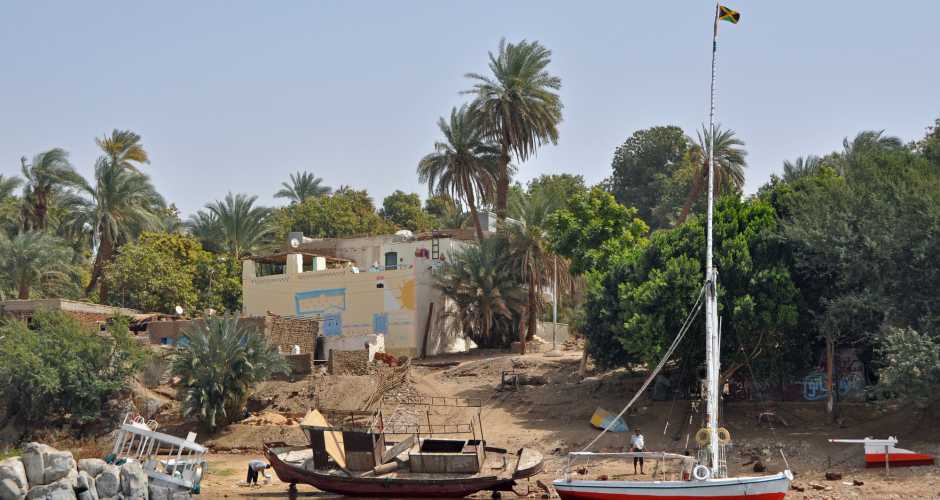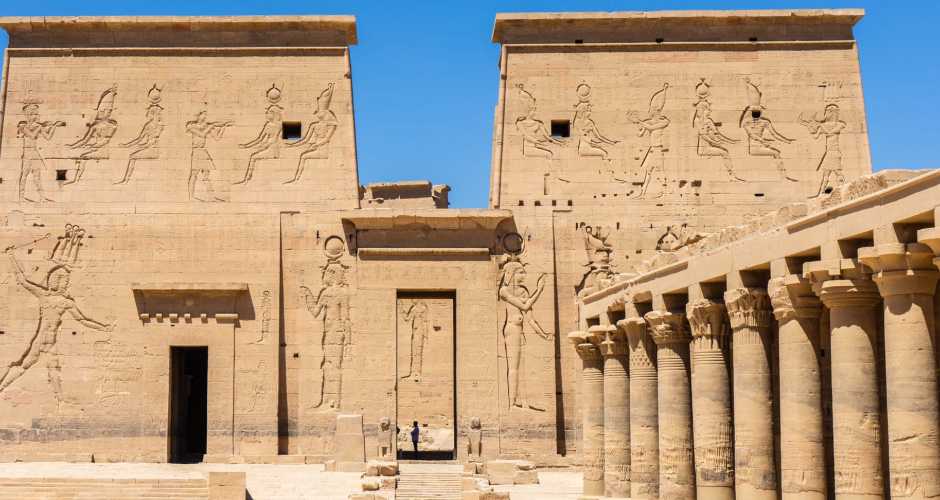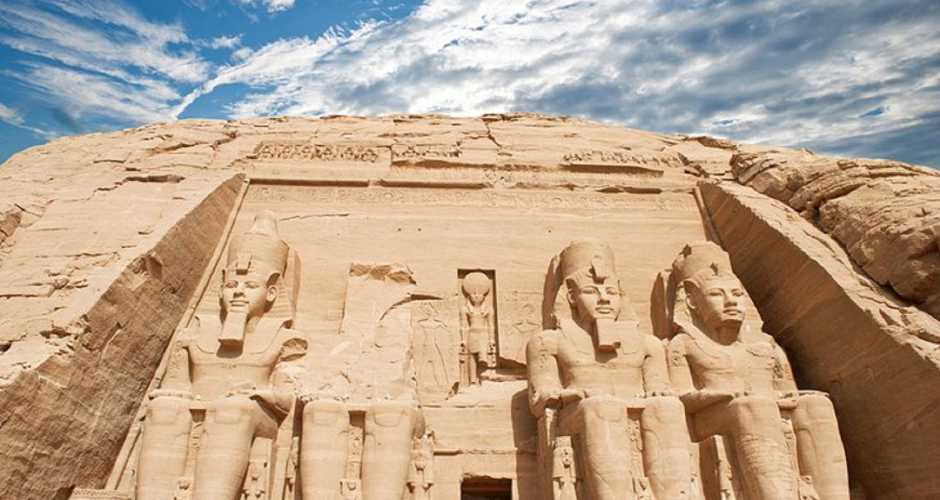
Top Attractions In Aswan
Aswan is a relaxed and friendly town that provides a tranquil interlude if you've just arrived from busier Luxor or Cairo. Aswan, a town on the Northern border of Nubia, was once one of the most important cities in Egypt. It lay on the trade route between Egypt and the Southern territories along which ivory, gold, slaves and exotic animals passed into Egypt. It has recently regained prime statQ.s with the development of iron foundries and aluminum mining in the area and the construction of the High Dam. At present the area is under military control. The aspect of the town is pleasant with a wide corniche and several markets. The best way to discover Aswan's charms is to hop aboard a felucca (traditional sailboat) and view town from the watery highway that once made Aswan an important trading post.The river here is speckled with islands holding picturesque mud-brick Nubian villages and hemmed by the West Bank's colossal sand dunes.
1. ELEPHANTINE ISLAND
Elephantine Island (Ar. Gazirat al-Aswan) lies in midstream opposite the modem town of Aswan. It is 2 km long and 500 m at its widest. There are two villages on the island which are independent of the mainland city. Two ferries serve the island, one from just North of the
Cataract Hotel to the South end of the island, the other from the Philae Hotel to the N end. Museum and resthouse near the Temple of Khnum. (Fee for visiting island and-museum.)
On this island was the ancient city of Abu, Gk Elephantine, the circular site of which is at the S end of the island. It is at present under investigation by a West German archaeological expedition. Prehistoric remains attest to the length of occupation of the island as do predynastic rock-carvings. The island was considered to be the home of Hapy, the Nile god, although the provincial god of the region was the ram-headed Khnum, Lord of the Cataract. Later there was a Jewish settlement here and many Aramaic papyri have been found.

2. THE NUBIAN MUSEUM
Nubian Museum is one of Egypt's best and a must for anyone interested in the history and culture of both ancient and modern Nubia. Inaugurated in 1997, the International Museum of Nubia, was dedicated to Nubian culture and civilization. It was awarded the Aga Khan Award for Architecture in 2001, which is an architectural prize established by Aga Khan IV in 1977.Surprise,


3. ASWAN HIGH DAM
Although the first Aswan dam (see above) had done much to alleviatedependence on the annual inundation of the Nile, it had not proved entirelysuccessful. In 1952 President Nasser announced his proposal for a larger dam,several kilometres up-stream, to deal with the problem once and for all. Havingmet with refusals to co-operate on the part of the western nations Nasser turned to the Russians. The result was the present structure which, unlike the earlier ones, is a rock-fill dam. It is 3600m long, of which 530m stretches between the two banks. The height above the river bed is 11 lm and the base is 980m wide. The top, which is 40m wide, contains a dual carriageway. There is also a hydro-electric plant with six turbines capable of producing 2.1 million kilowatts. Lake Nasser, which has built up behind the dam, is SOOkm long, thus stretching into the Sudan, and averages 10km wide. A four-lane highway runs across the top of the dam where there is a triumphal arch and an inscription commemorating the completion and the cooperation between Egypt and the Soviet Union to build it. Trips to the Aswan High Dam are often included on day trips to Abu Simbel, or you can easily hire a taxi to get here.

4. UNFINISHED OBELISK
The road to the first Aswan dam leaves S from the SW area of the town. To the E. (750m) are.the Northern Granite Quarries (fee), one
of the sites in the district where the red granite was cut from the 1 Dyn. onwards and transported throughout Egypt. The most impressive object here is an unfinished obelisk, 41.75m long, which if completedwould have weighed 1168 English tons. Although not inscribed, it is probably 18 or 19 Dyn.Owing the cutting a flaw was discovered in the stone and the length was reduced to 32.1m and its weight to 507 tons. The obelisk was cleared by Rex Engelbach, inspector of the Dept of Antiquities in 1922. The black paint outlining the work to be done was still dearly visible when he started work at the obelisk. He also found small round holes on the top surface of the obelisk filled with grains of black gunpowder, probably the remains of an attempt to split the granite by the Ottomans.

5.KALABSHA TEMPLE
Crossing the High Dam, the road turns S again to (750m) New Kalibshah, the site of three re-erected temples saved from the waters.
The temples are on an island (fee and special pennit required) reached by motor-boat. They are just a handful of the southern temples and forts that would have been below the new level of the lake. Others have gone to countries co-operating in the massive UNESCO rescue operations and a few have been abandoned and are now under water. Most impressive is the well-preserved Temple of Kalibshah, moved from its original site in 1970 by a team of West German engineers. The original site of this temple was Kalabshah (ancient Talmis), about 50km S of Aswan. Here the river once wound between cliffs, the Bab al-Kalabshah, with granite rocks breaking up the surface of the water, making navigation difficult. Talmis was certainly settled by the 18 Dyn. as Amenhotep II is shown in the outer vestibule of the temple. There was also a statue of Tuthmosis III lying in front of the temple early in this century, but its present whereabouts is unknown. The temple is built of sandstone blocks and is dedicated to Marul (Gk Mandulis), a Nubian fertility god who is also associated with sun worship; For some reason Wadjet, the goddess of Lower Egypt, is also closely associated with this temple and is represented throughout in the paintings. This temple, a reconstruction by one of the Ptolemies on an 18 Dyn. Just to the northwest is the Temple of Beit el-Wali ("House of the Holy Man") built by Ramses II and consisting of a vestibule, transverse chamber, and sanctuary. There are lively historical reliefs throughout the interior depicting many of Ramses II's battles and triumphs, including the king's triumph over the Kushites and his wars with the Syrians and Libyans.
Tiny Kertassi Temple sits just to the north and has two Hathor columns at the entrance and four other columns with elaborate floral capitals.

6. PHILAE TEMPLE
Agilqiyyah Island (Philae).
The island of *Agilqiyyah, onto which the structures from the submerged island of Philae have been transferred, has been reshaped
to resemble the conformation of Philae as closely as possible. With the building of the first Aswan Dam Philae was submerged for part of the year, and with the equalisation of the water flow produced by the High Dam it would have been permanently below water. Thus it was decided to move all the buildings and reconstruct them on this neighbouring island. This was a massive project taking over ten
years. A great coffer dam was erected around Philae and the temples were dismantled and transferred. They were finally opened on their new site in 1980. The earliest remains on the original island were of Taharqa (25 Dyn.) but the foundations have been removed to. theSouthern Quarry area.

7. ABU SIMBEL TEMPLE
If you have time for only one day trip from Aswan, pick a visit to Abu Simbel. Built by Ramses II, and saved from destruction by a remarkable UNESCO rescue project in the 1970s, Abu Simbel is not only a triumph of ancient architecture, but also of modern engineering. The mammoth scale of the Great Temple of Ramses II and the Temple of Hathor, sitting on the banks of Lake Nasser, trumps everything else in Egypt and has to be seen to be believed.

8.KOM OMBO TEMPLE
Back in time, the temple took place between the Nubian trade routes and the gold mines in the eastern desert, later, it became a training depot for the wild animals used in the war during the role of Ptolemy VII to fight the Seleucid empire, it was built during his reign as well .the area that the temple was constructed on used to be a favorite spot to the crocodiles to lay under the sun on the Nile shore, so it makes sense now to be dedicated to the crocodile god .some renovations were made later, such as the hypostyle hall which was added by Ptolemy the seventh 51-47B. C, Moreover, under the role of the emperor Trajan 53-117AD,the forecourt and outer walls were added.

9. MONASTERY OF ST. SIMEON
The history of the monastery of St. Simeon dates back to the 7th century, and survived long as a Christian stronghold of southern Egypt until destroyed by Saladin in 1173.The gloriously photogenic Monastery of St. Simeon sits between the sand dunes on the Nile's West Bank. Founded in the 7th century and finally abandoned in the 13th century due to water shortages, it's one of the largest and best preserved Coptic monasteries in Egypt.

10.TEMPLE OF WADI AL-SUBUA
Egypt's temple of Wadi Es-Sebua is located 50km south of Aswan Dam. It is known to be the second largest temple of Nubian region, after the famous temple of Abu-Simbel. This temple is named “Es-Sebua”, which means “Lions” and its name is justified due to the presence of the rows of lion-headed sphinxes before the entrance of the temple. They serenely but fiercely guard the entrance just as they have for centuries.

11. ASWAN BOTANICAL GARDENS
One of the best reasons to visit Aswan is to see the botanical gardens of Aswan. Travelers can sail on a local felucca boat or take a motor boat to the eastern bank of the Nile to reach this island. It is located opposite the city of Aswan and the elephantine island.
Kitchener’s Island, to the west of Elephantine Island, was given to Lord Horatio Kitchener in the 1890s when he was commander of the Egyptian army. Indulging his passion for beautiful palms and plants, Kitchener turned the entire island into the stunning Aswan Botanical Gardens, importing plants from the Far East, India and parts of Africa.

12. WESTERN QUARRY (GEBAL SIMAAN)
For archaeological-fiends, Aswan's Western Quarry makes an interesting trip. It was from here that much of ancient Egypt's most recognisable statuary began their life; chiseled out of the hillside of Aswan granite. Archaeologists think that Luxor's mammoth Colossi of Memnon come from this quarry. Today, you can still see the tracks where huge blocks of stone were dragged to the river for their journey down the Nile to grace the temples of the pharaohs. There are no roads here, so if you're up for a camel adventure, a visit here is also plenty of fun. Camel drivers can be hired at the Gharb Aswan boat landing and the trek takes about 30 minutes.
13. EDFU TEMPLE
Edfu is located 60km north of Aswan. It was the 2nd Nome of Upper Egypt and the center of the cult of a triad of gods, which consisted of Horus of Behdet, Hathor, and their son, Hor-Sama-Tawy. In the old Greek documents, Edfu was known as "Apollopolis Magna" because the Greeks identified Horus with their god Apollo. Edfu flourished in ancient times. Today, the most important monument in the city of Edfu is the Temple of Horus, one of the most beautiful and preserved Temples in Egypt. Its origins likely date back to the Second Intermediate Period, but the actual Temple only dates back to Ptolemaic times. The work of construction began during the reign of Ptolemy III (about 237 BC) and was finished during the reign of Ptolemy IV. Some other additions were made by other Ptolemaic Kings and the Roman Emperor Augustus. The temple's construction, in addition to its additions, inscriptions, and relief's took about 180 years!

14-THE NUBIAN VILLAGE
It is an awesome experience to see Beautifully Coloured Decorated homes of the Nubian and meet the Nubian people and Enjoy. Nubian Tea. You can enjoy an interesting walk through a small Nubian village. Nubian people in the south of Egypt have a different culture than people in the rest of the country.they got relocated to Aswan after building Aswan dam in 1964


